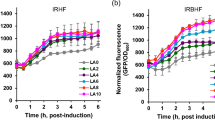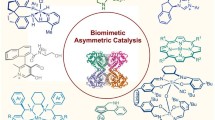Abstract
Chiral α-hydroxy acids (AHAs) are rapidly becoming important synthetic building blocks, in particular for the production of pharmaceuticals and other fine chemicals. Chiral compounds of a variety of functionalities are now often derived using enzymes, and L-lactate dehydrogenase from the thermophilic organism Geobacillus stearothermophilus (bsLDH) has the potential to be employed for the industrial synthesis of chiral α-hydroxy acids. Despite the thorough characterization of this enzyme, generation of variants with high activity on non-natural substrates has remained difficult and therefore limits the use of bsLDH in industry. Here, we present the engineering of bsLDH using semi-rational design as a method of focusing screening in a small and smart library for novel biocatalysts. In this study, six mutant libraries were designed in an effort to expand the substrate range of bsLDH. The eight variants identified as having enhanced activity toward the selected α-keto acids belonged to the same library, which targeted two positions simultaneously. These new variants now may be useful biocatalysts for chiral synthesis of α-hydroxy acids.


Similar content being viewed by others
References
Binay, B., Sessions, R. B., & Karagüler, N. G. (2013). A double mutant of highly purified Geobacillus stearothermophilus LDH recognizes mandelic acid as a substrate. Enzyme and Microbial Technology, 52, 393–399.
Senkpeil RF, Pantaleone DP. & Taylor PP. (2007). Inventors; Excelsyn Molecular Development Limited, assignee. Production of α-hydroxy-carboxylic acids using a coupled enzyme system. European patent EP, 1,326,993.
Zheng, Z., Zhao, M., Zang, Y., Zhou, Y., & Ouyang, J. (2015). Production of optically pure L-phenyllactic acid by using engineered Escherichia coli coexpressing L-lactate dehydrogenase and formate dehydrogenase. Journal of Biotechnology, 207, 47–51.
Mu, W. M., Yu, S. H., Zhu, L. Z., Zhang, T., & Jiang, B. (2012). Recent research on 3-phenyllactic acid, a broad-spectrum antimicrobial compound. Applied Microbiology and Biotechnology, 95, 1155–1163.
Garg, V. K., Sinha, S., & Sarkar, R. (2009). Glycolic acid peels versus salicylic-mandelic acid peels in active acne vulgaris and post-acne scarring and hyper pigmentation: a comparative study. Dermatologic Surgery, 35, 59–65.
Sakowicz, R., Kallwass, H. K., Parris, W., Kay, C. M., Jones, J. B., & Gold, M. (1993). Threonine 246 at the active site of the L-lactate dehydrogenase of Bacillus stearothermophilus is important for catalysis but not for substrate binding. Biochemistry, 32, 12730–12735.
El Hawrani, A. S., Sessions, R. B., Moreton, K. M., & Holbrook, J. J. (1996). Guided evolution of enzymes with new substrate specificities. Journal of Molecular Biology, 264, 97–110.
Reetz, M. T., & Carballeira, J. D. (2007). Iterative saturation mutagenesis (ISM) for rapid directed evolution of functional enzymes. Nature Protocols, 2, 891–903.
Reetz, M. T., Carballeira, J. D., Peyralans, J., Hobenreich, H., Maichele, A., & Vogel, A. (2006). Expanding the substrate scope of enzymes: combining mutations obtained by CASTing. Chemistry A European Journal, 12, 6031–6038.
Binay, B., Shoemark, D. K., Sessions, R. B., Clarke, A. R., & Karaguler, N. G. (2009). Increasing the substrate specificity of the lactate dehydrogenase from Bacillus stearothermophilus by DNA shuffling. Biochemical Engineering Journal, 48, 118–123.
Krieger, E., Koraimann, G., & Vriend, G. (2002). Increasing the precision of comparative models with YASARA NOVA—a self-parameterizing force field. Proteins, 47, 393–402.
Mayer, K. M., & Arnold, F. H. (2002). A colorimetric assay to quantify dehydrogenase activity in crude cell lysates. Journal of Biomolecular Screening, 7, 135–140.
Clarke, A. R., Smith, C. J., Hart, K. W., Wilks, H. M., Chia, W. N., Lee, T. V., Birktoft, J. J., Banaszak, L. J., Barstow, D. A., Atkinson, T., & Holbrook, J. J. (1987). Rational construction of a 2-hydroxyacid dehydrogenase with a new substrate specificity. Biochemical and Biophysical Research Communications, 148, 15–23.
Nicholls, D. J., Davey, M., Jones, S. E., Miller, J., Holbrook, J. J., Clarke, A. R., Scawen, M. D., Atkinson, T., & Goward, C. R. (1994). Substitution of the amino acid at position 102 with polar and aromatic residues influences substrate specificity of lactate dehydrogenase. Journal of Protein Chemistry, 13, 129–133.
Ishizuka, T., Ishibuchi, S., & Kunieda, T. (1993). Chiral synthons for 2-amino alcohols. Facile preparation of optically active amino hydroxy acids of biological interest. Tetrahedron, 49, 1841–1852.
Shioiri, T., Matsuura, F., & Hamada, Y. (1994). Use of the aryl groups as the carboxyl synthon. Application to the synthesis of some natural products containing hydroxy amino acid functions. Pure and Applied Chemistry, 66, 2151–2154.
Dunn, C. R., Wilks, H. M., Halsall, D. J., Atkinson, T., Clarke, A. R., & Muirhead, H. (1991). Design and synthesis of new enzymes on the lactate dehydrogenase framework. Philosophical Transactions of the Royal Society of London. Series B: Biological Sciences, 332, 177–184.
Hogan, J. K., Pittol, C. A., Jones, J. B., & Gold, M. (1995). Improved specificity toward substrates with positively charged side chains by site-directed mutagenesis of the L-lactate dehydrogenase of Bacillus stearothermophilus. Biochemistry, 34, 4225–4230.
Chapman, S. K., Reid, G. A., & Sinclair, R. (1998). Re-design of Saccharomyces cerevisiae flavocytochrome b2: introduction of L-mandelate dehydrogenase activity. The Biochemical Journal, 333, 117–120.
Acknowledgments
This work was supported by a grant from the TUBİTAK (grant number 213S099) and special thanks to COST Action (grant number CM1303).
Author information
Authors and Affiliations
Corresponding author
Rights and permissions
About this article
Cite this article
Aslan, A.S., Birmingham, W.R., Karagüler, N.G. et al. Semi-Rational Design of Geobacillus stearothermophilus L-Lactate Dehydrogenase to Access Various Chiral α-Hydroxy Acids. Appl Biochem Biotechnol 179, 474–484 (2016). https://doi.org/10.1007/s12010-016-2007-x
Received:
Accepted:
Published:
Issue Date:
DOI: https://doi.org/10.1007/s12010-016-2007-x




